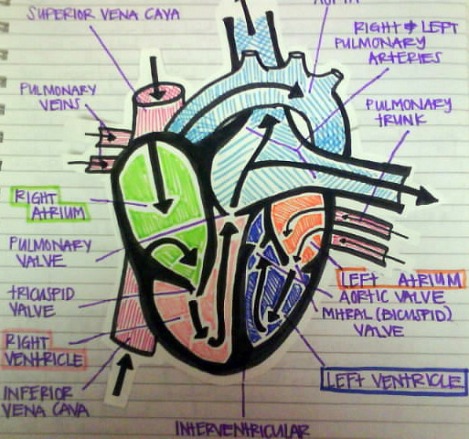April 15, 2009
Chapter 1: Exercise Physiology
Physiology is the study of the myriad functions in a living organism. Exercise Physiology is the study of the way cells and tissues of the body function during exercise.OPTIMUM FITNESS
- Physiological adaptations to exercise are specific to the system worked during the stress of exercise (ex: The type of exercise that developes cardiovascular endurance is not very effective for developing an optimum balance of muscular strength).
- Optimum physical fitness is The condition resulting from a lifestyle that leads to the developement of an optimal level of cardiovascular endurance, muscular strength, flexabilityas well as the acheivement and maintenance of an ideal body weight. (An individual must participate in cardiovascular, strength, & flexability to acheive optimum physical fitness.
DEFINITIONS
Cardiovascular endurance- The ability to perform large muscle movements over a sustained period, The capacity of the heart-lung system to deliver oxygen for sustained energy production.
Muscular Strength – Maximum amount of force a muscle or group of muscles can develope during a single contraction.
Muscular Endurance – Number of repeated contractions a muscle or muscle group can perform against a resistance without fatiguing, or the length of time a contraction can be held.
Flexability – The range of motion possible about a joint.
Range of motion – The number of degrees an articulation (joint) will allow one of it’s segments to move.
Body Composition – Weight on a scale consists of 2 dimensions: 1. Body fat (adipose tissue) 2. Fat free weight (muscles, bones, blood, organs, etc.)
Triglyceride – The storage form of fat consisting of 3 fatty acids & glycerol. (primary reserve of stored energy located between the skin & muscles & all over the body as well as within skeletal muscles)
% Body fat – Percentage of total body weight that is carried as fat. Body fat percentage of a fit individual falls between the range of 21-24% for women & 14-17% for men.
Fitness Testing
- The most important value of fitness testing is to establish a baseline against which improvements can be measured over time.
- Testing can be done in a controlled lab environment ( expensive equip, precision instruments) or field tests which use prediction equations developed by comparing data w/ lab tests that give personal trainers the ability to perform accurate assesments w/ out the need of expensive equipment.
PHYSIOLOGY OF THE CARDIOPULMONARY (CARDIOVASCULAR) SYSTEM

anatomy of the heart & pattern of blood flow through it
- The cardiopulmonary system is primarily a transport network in the body. CARDIO refers to the heart. PULMONARY refers to the lungs. VASCULAR refers to the blood vessels.
- Blood serves as the vehicle to carry gasses (O2) & nutrients (fats, amino acids, glucose) from where they are taken into the body to the cells where they are needed.
- Fats – An essential nutrient that provides energy, energy storage, and insulation, and contour to the body. (1 gram of fat = 9 kcals)
- Amino acid – Nitrogen-containing compounds that are the building blocks of protein.
- Glucose – A simple sugar, the form in which all carbs are used as the body’s principal energy source.
- Blood takes biproducts (ex. lactic acid & carbon dioxide) to where they can be expelled or metabolized.
- Lactic acid – A waste product of an anaerobic energy production known to cause localized muscle fatigue.
- The Cardiopulmonary system is composed of : THE HEART=pumps the blood THE LUNGS=where blood picks up O2 & gives up CO2 THE BLOOD VESSELS=transport the blood throughout the body.
- The 3 basic blood vessels are: ARTERIES, CAPILLARIES, & VEINS.
- Arteries – Carry blood w/ a fresh oxygen supply away from the heart to be delivered to the various cells & tissues.
- Capillaries – Where gases, nutrients, & cellular waste products are exchanged & supply blood to the tissues (smallest vessels)
- Veins – Carry deoxygenated blood back to the heart.
Hello world!
Welcome to WordPress.com. This is your first post. Edit or delete it and start blogging!